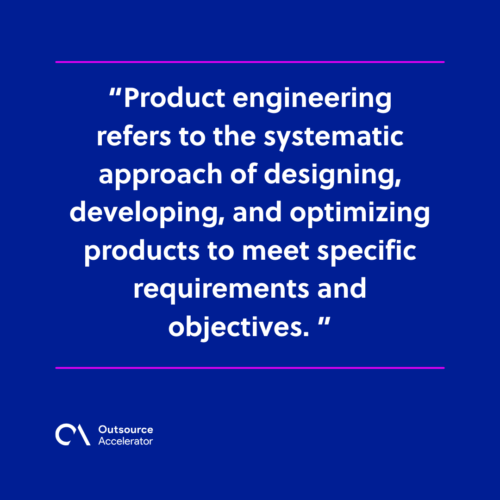6 product engineering best practices for notable outcomes

Software has become vital in virtually every aspect of modern life, powering everything from mobile apps to enterprise systems.
Product engineering is a fundamental aspect of software development. It ensures that software products are not only functional but also reliable, maintainable, and adaptable to evolving requirements and technologies.
Incorporating product engineering best practices allows firms to deliver high-quality products that provide value to users and drive business success.
What is product engineering?
Product engineering refers to the systematic approach of designing, developing, and optimizing products to meet specific requirements and objectives.
It involves applying engineering principles, methodologies, and techniques to create innovative and high-quality products that address customer needs and market demands.
Product engineering encompasses various stages of the product lifecycle, from conceptualization and design to manufacturing, testing, and deployment.
Its primary focus is on delivering reliable, efficient, cost-effective products tailored to user expectations and industry standards.

6 product engineering best practices
Here are six product engineering best practices to help development teams create software that not only meets but exceeds user expectations:
1. User-centered design
Product engineers ensure that the final product is intuitive, easy to use, and provides a positive user experience by:
- Conducting user research
- Gathering feedback
- Incorporating usability testing
It’s always important to prioritize user needs and preferences throughout the product development process. Software products must not only be functional and efficient but also delightful and engaging for the intended users.
2. Agile methodology
Embrace agile principles and practices to promote collaboration, flexibility, and iterative development.
Agile methodologies, such as Scrum or Kanban, enable product engineering teams to:
- Adapt to changing requirements
- Deliver incremental improvements
- Respond quickly to customer feedback
Agile divides projects into smaller, manageable tasks called sprints. Each sprint typically lasts between one to four weeks, during which cross-functional teams work together to deliver a functioning increment of the product.
3. Continuous integration and deployment (CI/CD)
Implement CI/CD pipelines to automate the process of building, testing, and deploying software updates. This practice reduces manual errors, speeds up release cycles, and enhances overall product quality by enabling frequent and reliable releases.
4. Cross-functional teams
Foster collaboration among cross-functional teams composed of individuals with diverse skills and expertise.
Product engineering teams can leverage collective knowledge, creativity, and perspectives by bringing together developers, designers, testers, and other stakeholders.
This innovative approach allows firms to deliver comprehensive and innovative solutions.
5. Modular and scalable architecture
Design software architectures that are modular, flexible, and scalable to accommodate future growth and changes.
Modular architectures promote code reusability, maintainability, and easier integration of new features. Scalability, on the other hand, ensures that the product can handle increased usage and data volume over time.
6. Continuous improvement and feedback loop
Cultivate a culture of continuous improvement by soliciting feedback from users, stakeholders, and team members.
Regular retrospectives, post-mortems, and performance metrics help identify areas for optimization, refine processes, and drive ongoing innovation in product engineering practices.

Outsource product engineering to power up software development
Datamatics prioritizes efficiency, scalability, and flexibility in its solutions, enabling businesses to adapt quickly to changing market demands and technological advancements.
This tech solutions provider boasts a team of highly skilled and experienced engineers who specialize in product development across various industries.
Their expertise in cutting-edge technologies ensures that businesses receive top-notch engineering services tailored to their specific requirements.
With Datamatics as a trusted partner, businesses can accelerate their product development cycles, drive innovation, and gain a competitive edge in today’s dynamic market landscape.
Get tailored product engineering solutions for your specific development project needs. Contact Datamatics today to get started!







 Independent
Independent




